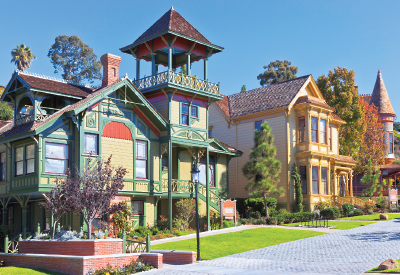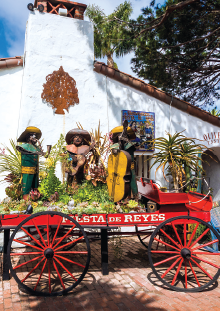When the dank mist spirals in from the Pacific Ocean and when the palm fronds rustle, you may possibly—just possibly—encounter an apparition in Old Town San Diego’s Whaley House.
The house, various visitors and psychics have attested, is chock full of apparitions from “Yankee Jim” to a long-haired girl in a longish dress, and even a terrier named Dolly. Yankee Jim—actually James Robinson—was hanged on the site where the house stands.
But even if the spirits elude you in Whaley House, it’s still worth a visit if you are a history buff. The same goes for all of Old Town San Diego, which lies north of today’s downtown San Diego and was the first Spanish settlement in California.
It all started in 1542 when the Spaniard Juan Cabrillo sailed into San Diego Bay and claimed the land for Spain. In 1769 a Spanish missionary arrived in the area. He established a mission and dedicated the first Spanish fort in California. By 1846, there were 250 Spanish settlers in the area, constituting a small town.
This town was under Mexican jurisdiction from 1822, when Mexico won independence from Spain, until 1846, when it was captured by a U.S. naval force. In 1850 the town was incorporated as a city, with government activities centering on the Plaza Viejo.
In 1868 a rival subdivision sprang up further south. The new subdivision became what is today known as downtown San Diego, and the original town became what is today known as Old Town San Diego—a historic site.
There are a number of restored original buildings as well as reconstructed buildings in Old Town that you can visit. Among them:
•
Casa de Carrillo, the oldest house in San Diego, was built between 1810 and 1820 by a settler named Francisco Ruiz. Ruiz planted a pear orchard, the first private planting of fruit trees in Southern California.
•
Casa de Estudillo was constructed in about 1825 by the Spanish aristocrat Jose de Estudillo. The adobe mansion, which is built around a garden courtyard, is considered one of Old Town’s outstanding show places.
•
Casa de Pedrorena was the residence of the Spanish aristocrat Miguel de Pedrorena, who made his home in San Diego from 1838 to 1850. Supporting the United States in the American-Mexican War of 1846-48, he became a captain in the U.S. cavalry. He was also one of the authors of the California constitution.
•
Old Town Plaza (Washington Square) was the center of public life and recreation in Old Town from its earliest days. Bullfights—free-for-alls for anyone who wanted to take on a bull—were staged here. Games, ceremonials, and trials were also held here.
•
Whaley House was built in 1856 by a successful businessman named Thomas Whaley, who had moved there from New York with his new wife, Anna. It was a two-story, Greek-Revival brick mansion on the corner of San Diego Avenue and Harney Street. Besides being home for five generations of Whaleys, the building has served as a dairy, general store, Sunday school, courthouse, theatre, saloon, and funeral parlor.
But history and an architectural lesson are only part of what Old Town San Diego offers. You can also enjoy good food and drink. For example, La Pinata is the oldest restaurant in Old Town and is renowned for its fajitas, tamales, Mexican-style lobster, and margaritas.
Once you have satisfied your thirst and palate, you can venture into Old Town shops. For instance, books about early California can be found in the Whaley House Museum Shop. Native-American jewelry and art can be purchased in the Covered Wagon and in Four Winds Trading Company. Men’s and women’s clothing are for sale in the Old Town Surf Shop. It is only one of the four retail buildings remaining in San Diego with a false storefront. And, inside, “cool classic skateboards hang from the ceiling,” described on Yelp reviewer. ■
Old Town San Diego State Historic Park, which is owned and operated by California State Parks, is located at 4002 Wallace Street. More information about Old Town can be accessed
here.


